The material was prepared by Anna Piunova,
Mountain.RU
Nuptse photos: Yuri Koshelenko
JURY KOSHELENKO
WINNER 13th PIOLET D'OR
Interview for Mountain.RU
Nuptse East south Pillar
, Nepal
Valeri Babanov, Yuri Koshelenko (RUS)
Route: Moonlight Sonata/south pillar Nuptse east
Length: 2400m
Grade: VI – 5, A3/A4, WI 6, M5
Strategy: Fixed ropes up to 6700m, return to Lukla, then four-day
ascent to reach summit.
Free climbing from 6900 to 7803m. Descent to base camp in two
days with one bivouac.
THE JURY PIOLET D'OR 2003
President: Jean Troillet
Hubert Giot (GHM)
Leslie Fucsko (GHM)
Adriano Favre (ITA)
Guy Chaumereuil (creator of Award)
The editors of Montagnes Magazine
Mick Fowler and Paul Ramsden (winners of the Piolet d’Or 2002).
|
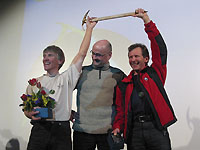
Ceremony of rewarding
Photo Olivier Moret, Montagnes Magazine, France
|
JURY, did you expect to become the winner
of the thirteenth Piolet d’or?
- Yes, I expected. I had an internal sensation
not connected to my mind but more likely with feeling at a mental
level, that we will be awarded. Thus I well understood, that there
were a lot of reasons against that. Certainly they are basically
the facts that it would be the second Piolet d’or for Valery and
as a whole the third for Russia. It is impossible. Though on total
merits we had 9 nominations - five at Valery and four at me. It
was a voice of heart.
|
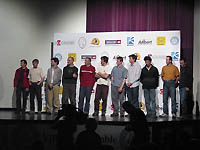
Legend nominated
From left to right: Yuri Koshelenko, Valery Babanov,
David Kaszlikowski, Marcin Tomaszewski, Ollie Sanders, Didier
Jourdain, Stuart Mcaleese, Kenton Cool, Aymeric Clouet,
Patrice Glairon-Rappaz, Stephane Benoist.
Ôîòî Olivier Moret, Montagnes Magazine, France
|
The basic competitors
- To tell the truth, Ian PARNELL, Kenton
COOL (UK) and John VARCO (EUA) with their ascent on ANNAPURNA
III, NEPAL. Jean Christophe Lafaille (FRA) on total merits
could really aspire as he was repeatedly nominated, but he has
never become the winner. I also liked a doublet of the young Frenchmen
Aymeric Clouet and Didier Jourdain: CHACRARAJU and JIRISHANCA
in Peru. JIRISHANCA is the top with a strong charisma.
Poles and Englishmen on CITADEL, ALASKA
made classical ascents not added anything in mountaineering. The
line of the Frenchmen Stephane Benoist and Patrice Glairon-Rappaz
(FRA) climbed THALAY SAGAR, INDIA practically coincides
with the line of Australians, once have already received for it
Piolet d’or.
|
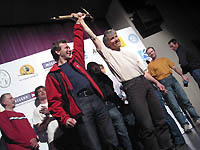
We' won the thirteenth Piolet
d’or!!!
Ôîòî Olivier Moret, Montagnes Magazine, France
|
Piolet d’or. A question about tendencies.
There are not any tendencies. I can not
tell that there are the rules. In my opinion we should speak about
a developed archetype of Piolet d’or.
The choice of the winner very strongly depends
on competence of a jury. Every year there are new persons in structure
of the jury though there are also constant participants (edition
of Montagnes Magazine and members of GHM group).
If to speak about novelty it is exactly
expressed in technically complex ascents on the walls of high
altitude with a difference of absolute height (above 7 thousand
meters).
Climbers feel like freely enough up to 7
thousand meters, but beautiful ascents on the summits higher than
7 thousand are found seldom enough.
“ New in world mountaineering ”
|

Autoportrait. Jury Koshelenko
|
- Now it is difficult to make something
new. Everything new includes the big element of uncertainty. People,
who go in mountains, cannot be adapted to the difficult situation,
which can occurs during an ascent. Sportsmen in other kinds where
uncertainty is not so much are adapted. Everything in mountaineering
is quite the contrary. Especially, when complex technical rocky
sites and high altitude above the sea level are combined.
Now climbing on big walls at low altitudes
has a smaller degree of uncertainty, than earlier. A lot of modern
technical devices and the available technical decision allow you
to come under a wall with a ready pattern of the actions, with
a portaledge, equipment, etc. The main thing is to choose correctly
a route and not to get under dangerous rockfall sites. Such very
extended walls as Trango (6300 m, 2 km difference of the altitude),
present a high degree of insistence. It is the wall, which it
is difficult to return from. When we were there, all participants
were ill by turns, one by one, and we had to somehow solve these
problems. Then periods of bad weather began. All this undermines
forces and conducts to accumulation of mistakes. After that expedition
I needed very long restoration - the mountain drank all forces.
|
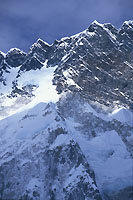
Nuptse route
|
The Route on Nuptse
- There was a little bit different picture
on Nuptse. The bottom part reminds most of all the route of Moshnikov
on Àk-Su, 6B graded. Besides it represents a danger of avalanches
and rockfalls. The first part is not technically complex, but
even a small avalanche gets exactly the place wherever you are.
Practically all ropes were beaten. We had to turn aside from stones.
During the final push a big stone flew missed Valery's face, passed
along all his body in 5 sm, literally, it could become the last
for him.
And before that we found the rope beaten
already having loaded it, it hung on two strings only. We had
to free climb that site with a backpack on shoulders just moving
jumar upwards.
|

First tower 5650
|
The next rope was thrown by improbable image
because of a strong wind, and I had to climb the cornice with
talus site instead of a convenient slope to remove it. It was
necessary to approach to the bridge and to exempt it. And then
I thought if such thing the assault began with what would be farther?
Though I also have resulted here above the
comparison our route with the route of Moshnikov, but there is
no the same relief on Nuptse, and there is moat snow. The snow
without a basis has property to form forms such as mushrooms,
a belt from icicles on edges, same fragile, as the usual icicles
usually hanging down from city roofs. Frequently we had to use
snowbars - snow stakes, not maintaining a jerk.
|
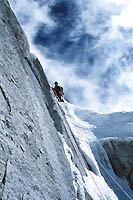
Babanov on the 6200
|
Vertical rocky sites À2-À4 added difficulties.
There is a site on Diamond Tower in height of 25 meters, going
to an small icefalls, which Jeff Law graded as À4 - offwidth.
On Diamond Tower, since the altitude of
6300 m, there are some serious rocky and mixed sites demanding
competent thinking, tactical actions, but not climbing “in stupid”…
The route very strongly depends on a seasonal
condition of the mountain - in the spring Valery climbed via one
places, and in the autumn - via another ones. Frequently the ropes
were just frozen into ice, i.e. they were practically unsuitable
for use. A maximum, I managed to dig out a small piece and to
make a belay. We climbed, basically, by free climbing.
The autumn route - is a lot of water ice,
Ì5/Ì5 +. In the bottom part there were rocky sites of VI category,
complex, with "mushrooms"; technically there was very heavy snow
of the sixth category. A summit tower Ì4, with sites of Ì5. The
condition of the route strongly varies seasonally, therefore some
sites can be classified differently.
Tactics
We fixed the ropes up to 6400 m, then rocky
and mixed relief ended, there was ice and snow "mushrooms". Further
we climbed in the Alpine style. We had to descend more and more
and passed difficult sites in the Alpine style. We meaningly made
acclimatization up to 6900 m, spent the night there and then descended.
After that we began to prepare to the final summit. It is typical
in general that there is no simple way for acclimatization in
the area.
|
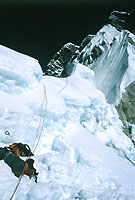
6500 first time
|
Route on Nuptse
The average part seemed a classical snow
route on one of the Russian Mountains of 7000m, 5-category graded.
Though it is impossible to compare on all parameters, but the
common characteristics are: the bergschrunds broken off, sites
where it is impossible to pass on foot, abrupt ice and mixed sites.
The entire route is difficult enough, everywhere
we had to belay, upper about 6500 m - the movement with the alternating
belay. On 6500 m there is small flattening of a ridge, then a
circuit of sharp crests, passing in traverse of the wall of the
ridge. We traversed on the wall, and complex climbed (4-5 categories)
up to 6900 m.
We installed a camp on 6900 m, and further
there is one more flattering on the ridge, which spreads and passes
in Southern face of Nuptse.
Camps
C1 - 6200m
C2 - 6900m
C3 - 7250m
C4 - 7450m
Route on Nuptse
After the camp we could climbed a simple
site simultaneously. Then the wall rose, and breaks began: hanging
icefalls, a lot of cracks, bergschrunds. It was enough complex
climbing with sites of strong abrupt 60º-65º ice.
|
Summit tower
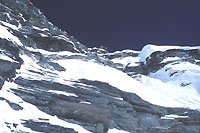
7450 ì
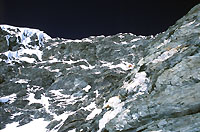
7700-7750 ì

7750 ì. Final photo.
|
Summit Tower.
It begins with two heavy pitches, (first-
IV +, the second V (VI)). Then some abrupt snow sites - a strip
snow. The crests go strips, i.e. all time you get in a hollow,and
climb it up on a crest (2 pitches). Then there are complex mixed
site, rocks, ice, snow, four - five pitches of Ì4/Ì5.
Features
A turn against a line of movement is characteristic.
It is the very much important point as we had to orient, whether
correctly we were climbing and to change a direction of movement.
During the moment when we made a decision, we could not answer
on this question unequivocally - the sun had already gone. Thus,
we had no confidence of correctness of the decision, though we
saw the ridge, and the tops were close.
We went out on the ridge in full darkness,
the night came, we did not give a damn about the belay and free
climbed.
|

After Summit 6.11.2003
|
The crest seemed very close, but it and
appeared far, more than 100 meters in extent. Up to the final
out we climbed belaying (IV category).
Route on Nuptse
The line of a route on Nuptse with its smooth
bends is evident at once … Perhaps, there is not present a charm
of the top as the mountain is topped with a series of peaks. There
is no precise recognition of the address, in difference, for example,
from Matterhorn or Ama Dablam. But the line is very beautiful,
natural, not without reason so many commands tried to complete
it up.

